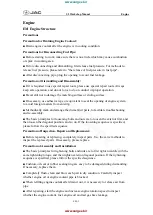
twigs can gather between the underbody and
the underbody panelling. If these materials
come in contact with hot parts of the exhaust
system, they can catch fire.
In such situations, have the vehicle checked
and repaired immediately at a qualified spe-
cialist workshop. If on continuing your jour-
ney you notice that driving safety is impaired,
pull over and stop the vehicle immediately,
paying attention to road and traffic condi-
tions. In such cases, consult a qualified spe-
cialist workshop.
When driving off-road, substances such as sand,
mud and water or water mixed with oil may get
into the brakes. This may lead to a reduction in
braking performance or total brake failure as a
result of increased wear. The braking charac-
teristics will vary depending on the substances
that get into the brakes. Clean the brakes after
driving off-road. If you notice grinding noises or
a reduction in braking performance, have the
brake system checked at a qualified specialist
workshop immediately. Adapt your driving style
to the altered braking characteristics.
Driving off-road increases the possibility of dam-
age to the vehicle, which may cause assemblies
or systems to fail. Adapt your driving style to the
conditions of the terrain. Drive carefully. Have
vehicle damage rectified immediately at a quali-
fied specialist workshop.
Do not shift into transmission position N when
driving off-road. You could lose control of the
vehicle if you attempt to brake the vehicle using
the service brake. If the gradient is too steep for
your vehicle, back up in reverse gear.
General notes
H
Environmental note
Protection of the environment is of primary
importance. Treat nature with respect.
Observe all prohibiting signs.
Read this section before driving your vehicle off-
road. Practise by driving over more gentle off-
road terrain first.
The following driving systems are specially
adapted to off-road driving:
R
the Offroad drive program (vehicles without
Off-Road Engineering package)
(
Y
page 228)
R
Offroad and Offroad Plus drive programs
(vehicles with Off-Road Engineering package)
(
Y
page 229)
R
LOW RANGE offroad gear (vehicles with the
Off-Road Engineering package)
(
Y
page 230)
R
Differential lock (vehicles with the Off-Road
Engineering package) (
Y
page 230)
R
Off-road ABS (
Y
page 69)
R
Off-road 4ETS (
Y
page 72)
R
Off-road ESP
®
(
Y
page 74)
R
AIRMATIC package (vehicle level)
(
Y
page 196)
R
DSR (Downhill Speed Regulation)
(
Y
page 227)
Observe the following notes:
R
Stop the vehicle before driving off-road. If
necessary, select the offroad program
(
Y
page 229) or shift to the LOW RANGE off-
road gear (
Y
page 230).
R
Select a vehicle level suitable for the off-road
terrain. To avoid damaging the vehicle, ensure
sufficient ground clearance at all times.
R
Make sure that items of luggage and loads are
stowed safely and are well secured
(
Y
page 316).
R
Always keep the engine running and in gear
when driving on a downhill gradient. Activate
DSR (
Y
page 227).
R
Drive slowly and evenly, if necessary at walk-
ing pace.
R
Ensure that the wheels are in contact with the
ground at all times.
R
Drive with extreme care on unknown off-road
routes where visibility is poor. For safety rea-
sons, get out of the vehicle first and survey
the off-road route.
R
Look out for obstacles such as rocks, holes,
tree stumps and furrows.
R
Take care when turning on an uphill or down-
hill slope or when driving across a slope. The
vehicle could otherwise tip over.
R
Always keep the doors, the tailgate and the
sliding sunroof closed while the vehicle is in
motion.
Driving tips
177
Dr
ivi
ng
an
d
parki
ng
Z
















































